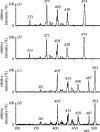Preservation of hypericin and related polycyclic quinone pigments in fossil crinoids
- PMID: 16615212
- PMCID: PMC1560208
- DOI: 10.1098/rspb.2005.3358
Preservation of hypericin and related polycyclic quinone pigments in fossil crinoids
Abstract
The fringelite pigments, a group ofphenanthroperylene quinones discovered in purple coloured specimens of the Upper Jurassic crinoid Liliocrinus, demonstrate exceptional preservation of organic compounds in macrofossils. Here we report the finding of hypericin and related phenanthroperylene quinones in Liliocrinus munsterianus from the original 'Fringeli' locality and in the Middle Triassic crinoid Carnallicrinus carnalli. Our results show that fringelites in fact consist ofhypericin and closely related derivatives and that the stratigraphic range of phenanthroperylene quinones is much wider than previously known. The fossil occurrence of hypericin indicates a polyketide biosynthesis of hypericin-type pigments in Mesozoic crinoids analogous to similar polyketides, which occur in living crinoids. The common presence of a characteristic distribution pattern of the fossil pigments and related polycyclic aromatic hydrocarbons further suggests that this assemblage is the result of a stepwise degradation of hypericin via a general diagenetic pathway.
Figures





Similar articles
-
Persistent and widespread occurrence of bioactive quinone pigments during post-Paleozoic crinoid diversification.Proc Natl Acad Sci U S A. 2015 Mar 3;112(9):2794-9. doi: 10.1073/pnas.1417262112. Epub 2015 Feb 17. Proc Natl Acad Sci U S A. 2015. PMID: 25730856 Free PMC article.
-
Structure and Absolute Configuration of Phenanthro-perylene Quinone Pigments from the Deep-Sea Crinoid Hypalocrinus naresianus.Mar Drugs. 2021 Aug 3;19(8):445. doi: 10.3390/md19080445. Mar Drugs. 2021. PMID: 34436285 Free PMC article.
-
Determination of enantiomerization barriers of hypericin and pseudohypericin by dynamic high-performance liquid chromatography on immobilized polysaccharide-type chiral stationary phases and off-column racemization experiments.Chirality. 2010 May 15;22(5):463-71. doi: 10.1002/chir.20764. Chirality. 2010. PMID: 19644936
-
Crinoids: ancient organisms, modern chemistry.Nat Prod Rep. 2017 Jun 7;34(6):571-584. doi: 10.1039/c6np00093b. Nat Prod Rep. 2017. PMID: 28357435 Review.
-
Fossil record of echinoderm regeneration with special regard to crinoids.Microsc Res Tech. 2001 Dec 15;55(6):397-402. doi: 10.1002/jemt.1186. Microsc Res Tech. 2001. PMID: 11782070 Review.
Cited by
-
Boron-containing organic pigments from a Jurassic red alga.Proc Natl Acad Sci U S A. 2010 Nov 9;107(45):19374-8. doi: 10.1073/pnas.1007973107. Epub 2010 Oct 25. Proc Natl Acad Sci U S A. 2010. PMID: 20974956 Free PMC article.
-
Phanogracilins A-C, New Bibenzochromenones of Crinoid Phanogenia gracilis (Hartlaub, 1890).Biomolecules. 2024 Jan 26;14(2):151. doi: 10.3390/biom14020151. Biomolecules. 2024. PMID: 38397388 Free PMC article.
-
Perylenequinones: Isolation, Synthesis, and Biological Activity.European J Org Chem. 2012 Jul 1;2012(21):3887-3904. doi: 10.1002/ejoc.201200184. European J Org Chem. 2012. PMID: 24039544 Free PMC article.
-
Taphonomic variation in vascular remains from Mesozoic non-avian dinosaurs.Sci Rep. 2025 Feb 5;15(1):4359. doi: 10.1038/s41598-025-85497-y. Sci Rep. 2025. PMID: 39910217 Free PMC article.
-
Persistent and widespread occurrence of bioactive quinone pigments during post-Paleozoic crinoid diversification.Proc Natl Acad Sci U S A. 2015 Mar 3;112(9):2794-9. doi: 10.1073/pnas.1417262112. Epub 2015 Feb 17. Proc Natl Acad Sci U S A. 2015. PMID: 25730856 Free PMC article.
References
-
- Bather F.A. The Crinoidea of Gotland. Part I. The Crinoidea Inadunata. Kongliga Svenska Vetenskaps-Akademiens Handlingar. 1893;25:1–200.
-
- Behar F, Budzinski H, Vandenbroucke M, Tang Y. Methane generation from oil cracking: kinetics of 9-methylphenanthrene cracking and comparison with other pure compounds and oil fractions. Energy Fuels. 1999;13:471–481. doi:10.1021/ef980164p - DOI
-
- Biese W. Ueber die Encriniten des unteren Muschelkalkes von Mitteldeutschland. Abhandlungen der Preußischen Geologischen Landesanstalt, Neue Folge. 1927;103:1–119.
-
- Blumer M. Fossile Kohlenwasserstoffe und Farbstoffe in Kalksteinen. Mikrochemie. 1951;36/37:1048–1055. doi:10.1007/BF01460908 - DOI
-
- Blumer M. Pigments of a fossil echinoderm. Nature. 1960;188:1100–1101.
Publication types
MeSH terms
Substances
LinkOut - more resources
Full Text Sources
Miscellaneous

